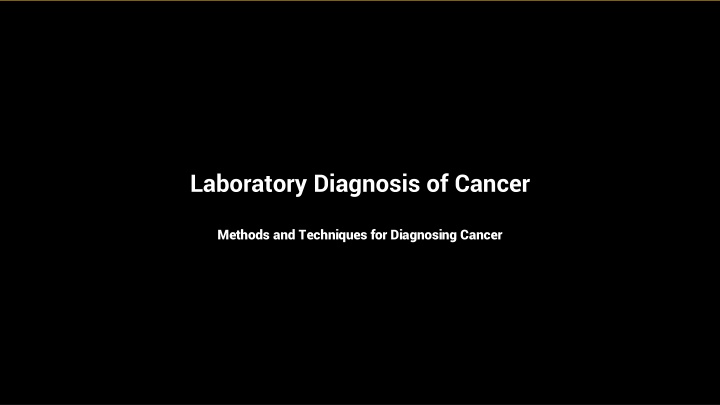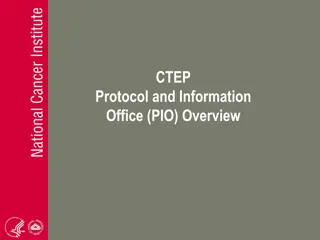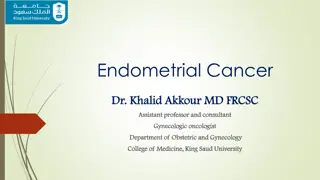Laboratory Diagnosis of Cancer
Exploring various methods and techniques used in the laboratory diagnosis of cancer. This comprehensive guide delves into the intricate processes involved in identifying and confirming cancerous conditions through cutting-edge technologies and expert analysis. From sample collection to result interpretation, this resource equips readers with a detailed understanding of the innovative approaches utilized by medical professionals in the accurate diagnosis of cancer. A must-read for those interested in the field of oncology and seeking to enhance their knowledge of cancer detection methods.
Download Presentation

Please find below an Image/Link to download the presentation.
The content on the website is provided AS IS for your information and personal use only. It may not be sold, licensed, or shared on other websites without obtaining consent from the author.If you encounter any issues during the download, it is possible that the publisher has removed the file from their server.
You are allowed to download the files provided on this website for personal or commercial use, subject to the condition that they are used lawfully. All files are the property of their respective owners.
The content on the website is provided AS IS for your information and personal use only. It may not be sold, licensed, or shared on other websites without obtaining consent from the author.
E N D
Presentation Transcript
Laboratory Diagnosis of Cancer Methods and Techniques for Diagnosing Cancer
Introduction Welcome to Pathology Made Simple tutorial on the laboratory diagnosis of cancer In this presentation, we will discuss various methods utilized to diagnose cancer and their utilities in cancer management Physicians thoroughly examine patients for vague symptoms and clues for cancer diagnosis Routine blood investigations can reveal anemia or polycythemia, which may be secondary to underlying malignancy Photo by Pexels Photo by Pexels
Cytopathological Examination Cytopathological examination involves studying studying cells for cancer diagnosis Cells for diagnosis can be obtained through exfoliative cytology or interventional cytology Exfoliative cytology involves spontaneously shed cells from organ linings, such as Pap smears for cervix lesions Interventional cytology involves obtaining cells through active intervention, e.g., fine needle aspiraion cytology
Histopathological Examination Histopathological examination involves diagnosing cancer based on microscopic features of the neoplasm Tissues for examination can be obtained through needle biopsy, endoscopic biopsy, incision biopsy, or excision biopsy Needle biopsy involves taking a small chunk of chunk of tissue through a core needle Endoscopic biopsy is performed during gastrointestinal endoscopy procedures Incision biopsy involves taking a part of the lesion along with normal tissue Excision biopsy involves removing the entire tumor along with surrounding tissue
Immunohistochemistry Immunohistochemistry is a special investigation used to detect specific proteins in tissue sections Antibodies are used to recognize and bind to the target proteins Markers are used to visualize the antigen- antibody complex Immunohistochemistry helps in determining the nature of the tumor, extent of tumor involvement, and categorizing undifferentiated cancer
Flow Cytometry Flow cytometry is a technique used to analyze cell properties as they pass through a fluid stream Light scattering is used to obtain information about the cells Flow cytometry helps in identification and characterization of specific types of cancers Photo by Pexels Photo by Pexels
Molecular Techniques Molecular techniques involve studying the genetic makeup of cancer cells Polymerase Chain Reaction (PCR) is used to detect and amplify specific DNA sequences Fluorescence in situ hybridization (FISH) is used to detect genetic changes and chromosomal abnormalities Gene sequencing is used to identify mutations and other genetic changes Next Generation Sequencing (NGS) is an advanced method for reading DNA in a short amount of time Photo by Pexels Photo by Pexels
Imaging Techniques Imaging techniques like X-rays, ultrasound, computed tomography (CT) scan, magnetic resonance imaging (MRI), and positron emission tomography (PET) are used in cancer diagnosis Each technique uses different technologies to produce detailed images of the body Imaging techniques can be used alone or in combination for diagnosing cancers Photo by Pexels Photo by Pexels
Liquid Biopsy Liquid biopsy is a technique that uses blood to detect the genetic makeup of cancers Circulating tumor DNA (ctDNA) test detects DNA shed by cancer cells in the blood Liquid biopsy provides real-time information about the presence of cancer and can be used to monitor response and detect minimal residual disease Photo by Pexels Photo by Pexels
Tumor Markers Tumor markers are products of tumors that can be detected in cells, blood, or body fluids Tumor markers can be used to monitor the progression of the disease and evaluate the effectiveness of cancer treatment Examples of tumor markers include prostate- specific antigen (PSA), cancer antigen 125 (CA125), and alpha-fetoprotein (AFP) Photo by Pexels Photo by Pexels
Conclusion In conclusion, the laboratory diagnosis of cancer involves multiple methods and techniques Each method has its own advantages and utilities in cancer diagnosis and management A combination of physical examination, laboratory investigations, imaging, and molecular techniques provides a comprehensive approach to cancer diagnosis It is important to integrate these diagnostic methods for accurate and conclusive cancer diagnosis Photo by Pexels Photo by Pexels























